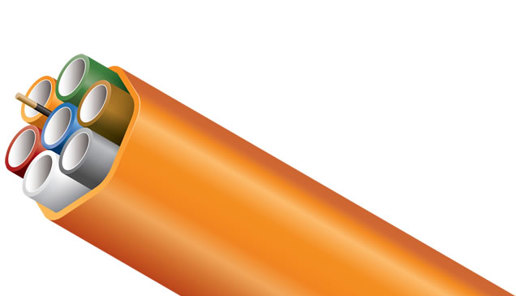Let’s Talk about Fiber
Posted: July 17, 2024

Understanding Innerduct
What is Innerduct?
Innerduct, sometimes referred to as duct, offers several advantages in underground fiber deployments:
Protection
- Physical Protection: Ducts provide a layer of physical protection for the fiber cables against external damage from environmental factors, rodents, and accidental digging.
- Water and Chemical Resistance: Ducts help prevent water ingress and protect cables from chemicals and other corrosive substances in the soil.
Maintenance and Upgrades
- Ease of Installation and Replacement: Ducts allow for easier installation of fiber cables and make it simpler to replace or upgrade cables without digging up and disrupting the entire trench.
- Futureproofing: Installing ducts during the initial deployment allows for future upgrades and expansions. Additional cables can be pulled through existing ducts without new excavation, saving time and costs.
Cost-Effectiveness
- Reduced Long-Term Costs: Although the initial cost of installing ducts is higher, it can lead to reduced maintenance and repair costs over time, making it a cost-effective solution in the long run.
- Minimized Downtime: Easier access for repairs and upgrades means less downtime, crucial for maintaining service reliability and customer satisfaction.
Flexibility
- Multiple Cable Types: Ducts can accommodate different types of fiber cables, allowing network design and deployment versatility.
- Scalability: Ducts facilitate the scaling of network infrastructure as demand grows, enabling the addition of more cables without significant excavation work.
- Let’s face it: the fiber world is full of acronyms, and deciphering them can leave you with whiplash. Let’s take a moment to learn a few duct terminologies, acronyms, and their applications.
Various duct options are available, whether you choose to jet (sometimes called blow) or pull your fiber. It’s essential to familiarize yourself with the following:
Straight-Walled Innerducts
Straight-walled innerducts are high-density polyethylene (HDPE) pipes with excellent low-temperature properties.
SDR (Standard Dimensional Ratio)
SDR refers to the ratio between the outer diameter (OD) and the wall thickness of the pipe. The smaller the ratio, the thicker the wall. The most common SDRs used in fiber deployment are SDR 11 and SDR 13.5.
- SDR 11: This thick-walled pipe is more crush-resistant, making it suitable for deployment in rocky terrain. Its thicker walls also mean it has a higher PSI rating, up to 160 PSI.
- SDR 13.5: This pipe has a slightly thinner wall and is more malleable than SDR 11. It is ideal for deployments in clay and sandy areas and has a PSI rating of 130.
Microduct / Multi-duct
Labor costs account for up to 80% of the total cost of a fiber build. So why go through all that expense and only install one duct when you can future-proof your network with multiple ducts for just a few pennies more per foot?
The purpose of microduct in fiber optic deployments is to provide a compact, flexible, and efficient pathway for fiber cables. Here are the key benefits and purposes of using microduct:
- Space Efficiency: Microducts are smaller in diameter than traditional ducts, allowing multiple microducts to be installed in the same space as a single larger duct. This is particularly useful in congested urban environments or where space is limited.
- Flexibility: Microducts are highly flexible, making them easier to install around bends and curves in the route. This flexibility reduces the need for extensive civil engineering work and allows for more versatile routing options.
- Futureproofing: Installing microducts allows for easy expansion of the fiber network. As demand increases, additional fiber cables can be blown into the microducts without the need for new excavation or significant disruption.
- Cost-Effectiveness: Microducts can reduce overall installation costs. Their smaller size and flexibility can lead to lower material and labor costs compared to traditional ducts. Additionally, adding fibers in the future without significant construction saves money over time.
- Ease of Installation and Maintenance: Microducts facilitate the easy installation of fiber optic cables using air-blowing techniques. This method is faster and less labor-intensive than traditional pulling methods. Maintenance and repairs are simplified, as individual fibers can be replaced or added without disturbing existing cables.
- Reduced Environmental Impact: Microducts' smaller size and less invasive installation methods can minimize environmental impact. Less soil needs to be excavated, and the surrounding area is less disrupted.
- High Density: Microducts allow for high-density fiber deployments, essential in areas requiring significant bandwidth and connectivity, such as data centers, metropolitan areas, and business districts.
- Improved Performance: The controlled environment within the microduct protects the fiber cables from external damage and environmental factors, ensuring optimal performance and longevity of the network.
Applications of Microduct:
- FTTH (Fiber to the Home): Microducts are commonly used in FTTH deployments, providing an efficient and scalable solution for residential areas.
- Enterprise Networks: Businesses and office buildings benefit from the high-density and flexible installation options of microducts.
- Data Centers: Microducts' high-density capacity is ideal for data centers, where space and scalability are critical.
- Campus Networks: Educational institutions and large campuses use microducts to create robust and easily expandable network infrastructures.
- Telecommunication Networks: Telecommunication providers use microducts to expand their fiber optic networks efficiently and cost-effectively.
- MDUs: Multi-dwelling units benefit from microducts for efficient and scalable network installations.
Additional Options Available for Ducts:
- Pull Tape: Heavyweight mule tape pre-installed in the pipe is used for pulling fiber rather than blowing fiber. Pull tape is not available in smaller diameter ducts such as microducts.
- Tracer Wire: Some manufacturers offer the option of a tracer wire being molded into the duct itself. Tracer wires allow for sending a tone along the pipe's path, which is used for utility locating purposes.
- Ribbed In/Out: HDPE duct with inner and outer ribs. The internal longitudinal ribs reduce the coefficient of friction, while the external ribs help prevent spiraling and reduce friction when pulling innerduct into larger conduits.
- Permanent Lubricant: A specially formulated silicone lubricant emulsion can be added to the inner wall during manufacture. This lubricant can reduce the friction coefficient by up to 60%.
If you’d like to learn more about fiber or explore our complete line of products, please contact your dedicated MBSI WAV account representative.

